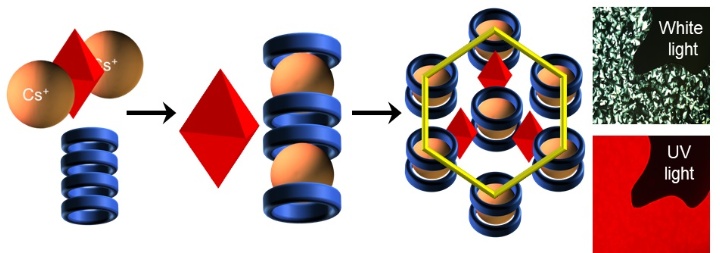
Innovative Alternatives to Rare Earth Metal Oxides for Energy Conversion

Embedding phosphorescent caesium metal clusters (red octahedrons) in organic liquid crystals (blue rings) produces hybrid nanomaterials that emit intense red light when irradiated with UV light.
Photo: University of Stuttgart/ IOC
Nowadays energy conversion in lighting and optoelectronic devices requires the use of rare earth oxides.
However, due to their limited availability from natural resources located outside Europe rare earth oxides are considered as strategic minerals.
Therefore, alternative materials are highly desirable for energy efficient lighting and other applications.
Starting in January 2019 the Deutsche Forschungsgemeinschaft (DFG) and the French Agence Nationale de la Recherche (ANR) will be funding the Franco-German joint project SNAPSTER (Supramolecular nanomaterials containing phosphorescent transition metal clusters), which involves three research teams from the University of Stuttgart and the University of Rennes.
The aim of the SNAPSTER project is the integration of inorganic, phosphorescent metal clusters in organic liquid crystals via supramolecular interactions.
The liquid crystals are acting as isolating shell and improve the photophysical properties of the resulting hybrid materials and their chemical stability.
The emission wavelengths can be tailored by suitable choice of the metal cluster. SNAPSTER is based on the longstanding complementary expertise of the collaborating teams regarding organic material synthesis and characterization (Sabine Laschat, Stuttgart), inorganic cluster synthesis, photophysical characterization and preparation of hybrid materials (Yann Molard, Rennes) and the integration of these novel materials into electronic devices (Emmanuel Jacques, Rennes).
Sabine Laschat, Institut für Organische Chemie, Universität Stuttgart,
sabine.laschat@oc.uni-stuttgart.de












